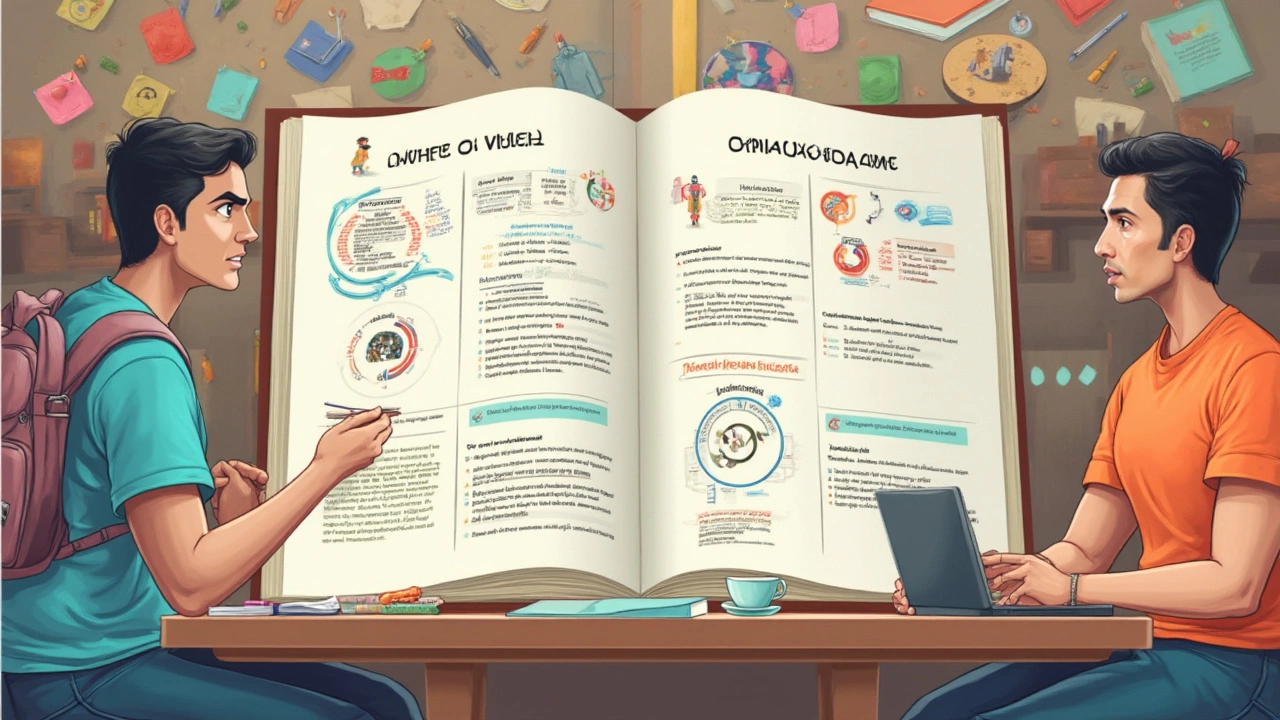
You hear the word 'diploma' everywhere in India—after Class 10, in polytechnics, even in government job ads. Yet, if you ask three different students what a diploma actually means, you’ll probably get three different answers. Some folks think it’s a shortcut to a job, others believe it’s a backup plan, and a few just nod without really knowing. Fact is, in the Indian education maze, the definition of a diploma isn't as simple as it seems.
What is a Diploma in India?
In India, a diploma is a qualification granted by an educational institution after completing a specific course, typically shorter than a degree program. Most diploma courses focus on hands-on skills and direct job readiness. Unlike undergraduate degrees (like B.A., B.Sc., B.Com), diploma programs are usually completed in one to three years and center on practical, career-oriented subjects. The term "diploma" mostly refers to post-secondary qualifications, but it pops up in several contexts—from engineering to nursing to catering. The formal recognition of diplomas often comes under the regulation of technical boards or councils, such as the All India Council for Technical Education (AICTE) or State Technical Education Boards.
Here's where things get tricky: not all diplomas are the same. There are different levels—post-secondary diplomas after Class 10 or Class 12, and even postgraduate diplomas after graduation. In everyday language, when someone says “diploma course,” they usually mean those technical or vocational courses started after Class 10 or 12, especially in polytechnic institutes. For instance, after Class 10, students can enroll in a three-year Diploma in Engineering (Polytechnic), which is recognized for many entry-level technical jobs. On the other hand, there are postgraduate diplomas in fields like business management or computer applications, usually offered after a bachelor’s degree.
The Government of India, through the National Policy on Education, and bodies like the University Grants Commission (UGC), have drawn lines between diplomas, degrees, and certificates. Properly speaking, a diploma covers a mid-level qualification—more than a certificate, less than a degree, but it can open just as many doors if you choose wisely. A 2022 AICTE report noted, “More than 8 lakh students graduate with a diploma in engineering every year, with nearly 60% finding employment within the first year.” That’s a mammoth number, showing just how deeply embedded diplomas are in the education story of India.
India also recognizes diplomas at different educational levels. There are:
- Diploma after Secondary Education (Class 10): Popular for fields like engineering (polytechnic), hotel management, and ITI courses (Industrial Training Institute).
- Diploma after Senior Secondary (Class 12): Courses such as Diploma in Nursing, Elementary Education, or Medical Lab Technology.
- Postgraduate Diplomas: Targeted at graduates wanting to specialize, like PG Diploma in Data Science, Mass Communication, or Business Administration. These do not count as master’s degrees but can boost job prospects massively.
Where Do Diplomas Fit in the Indian Education System?
Let's clear the fog—where exactly do diplomas slot into the Indian education hierarchy? Picture the system as a multi-storied building. The degree courses—BA, BTech, BSc—usually take the upper floors. The ground and first floors are where diplomas and certificates live. Diploma courses are designed to act as a bridge between basic schooling and higher professional study or direct employment. Unlike the general academic route, diplomas almost always link back to practical tasks: think of automobile engineering, fashion design, or early childhood education.
One thing that sets the Indian context apart is the formal value attached to diplomas. In many State and Central Government job notifications, a recognized three-year diploma in engineering or technology is viewed at par with a Class 12 plus some training, or even with a degree, for certain posts. Take the Staff Selection Commission (SSC) and Indian Railways: Both offer technical job avenues exclusively for diploma holders—sometimes with better chances for promotion over equivalent degree holders in technical roles. No wonder so many families see a diploma as a smart, job-oriented choice, especially if immediate employment is the goal.
The National Skill Qualification Framework (NSQF) is another piece of the puzzle. Introduced to bring parity across different types of vocational and formal qualifications, the NSQF rates diplomas typically at Level 5 or 6, compared to bachelor’s degrees at Level 7. While this might sound technical, it sets a clear roadmap for students to move up the ladder—even from diploma to degree, through lateral entry pathways. For example, students who complete the Diploma in Engineering after Class 10 often get direct entry into the second year of Bachelor of Engineering (BE/BTech) programs—a process called "lateral entry." This creates a smooth transition for those who want both a quick start in the job market and options for future academic growth.
The regulatory environment is quite robust. The AICTE, the UGC, state technical boards, and professional councils all play roles in setting standards, syllabus, and accreditation for diploma programs. AICTE-approved diplomas are widely accepted across India—crucial for government jobs and public sector undertakings (PSUs) recruitment. State governments also run their own technical boards (like Maharashtra State Board of Technical Education, or MSBTE) to control and certify polytechnic courses. There’s a widespread belief—sometimes true, sometimes not—that diplomas are "easier" than degrees. In reality, the coursework can be just as tough, and pass percentages in government colleges often hover around 45-50%: proof that it’s no cakewalk.
So, is a diploma the same as a degree in India? While both are qualifications, they’re not interchangeable. A diploma focuses on applied skills, meant to jumpstart a career; a degree digs deeper, with a broader academic base, and often leads to postgraduate study. People sometimes get confused because “diploma” can also refer to what you physically receive after finishing a degree. But technically, the education boards mean distinct programs when they talk about diploma vs. degree.

Different Types of Diploma Courses You’ll Find in India
The range of diploma courses in India is huge, and that’s not just an exaggeration. You’ll find programs for nearly every sector. Some of the most popular include:
- Diploma in Engineering: Offered after Class 10 or 12; streams include Mechanical, Civil, Electrical, Electronics, and Computer Engineering.
- Diploma in Pharmacy (DPharm): A two-year course recognized by the Pharmacy Council of India, allowing you to register as a pharmacist.
- Diploma in Education (D.Ed or D.El.Ed): Required for pre-primary and primary teaching jobs, especially in government schools.
- Diploma in Nursing or Auxiliary Nursing & Midwifery (ANM): For those who want to work in hospitals and clinics as nurses or midwives.
- ITI Diplomas (Industrial Training Institutes): Focus on trades like Electrician, Fitter, Welder, Diesel Mechanic, and more. ITI diplomas are regulated by the Directorate General of Training (DGT), under the Ministry of Skill Development and Entrepreneurship.
- Polytechnic Diplomas: Not just engineering—these include Hotel Management, Fashion Designing, Interior Designing, etc.
- Post Graduate Diplomas: Diploma in Management (PGDM), Software Engineering, Clinical Research, Data Analytics—offered by universities, autonomous institutes, and government training bodies.
Tech institutes and polytechnics have been the backbone of the diploma ecosystem. Maharashtra, Tamil Nadu, and Karnataka are known for their massive polytechnic networks, each running hundreds of government and private colleges. As per the Ministry of Education’s 2023 data, more than 12,000 institutes in India offer diploma or certificate-level courses, with more than 2.5 million students enrolled annually. That’s not a fringe crowd by any measure.
One overlooked area? The creative fields. Not every diploma leans on labs and machines. Courses in animation, graphic design, digital marketing, event management, mass communication, and journalism are seeing a surge as students opt for new-age careers. These diplomas usually run for 6-18 months and directly target emerging industries. For many, it’s the fastest way to build a portfolio and score an internship or entry-level job right out of the gate.
As for the entry requirements, each diploma has its own rules—most polytechnic diplomas need a minimum pass in Class 10. Postgraduate diplomas demand a bachelor’s degree. Some, like a Diploma in Pharmacy or Teacher Training, need you to clear entrance exams or go through counseling rounds.
Now, let’s bust a myth: a diploma isn’t always a “second-class” choice compared to a degree. Ask any successful technician, skilled nurse, or creative director who started with a diploma course. Jobs in sectors like private manufacturing, construction, railways, hospitality, information technology, and the health sector often hire diploma holders for specialized roles—and pay industry-standard salaries too.
If you’re the kind who wants to hit the workforce early, or you like to learn by doing (instead of endless theory), a diploma can be a game-changer. Several multinational companies actively hunt for diploma graduates in production, quality control, logistics, and service roles. A study by TeamLease EdTech in 2022 highlighted that "diploma holders saw the highest increase in vocational employment, especially in southern and western states." That’s a loud endorsement from the job market itself.
Tips and Insights: Choosing the Right Diploma Course in India
Alright, so you’re interested in a diploma course—but how do you pick the right one? With so many options, it’s easy to get overwhelmed, or worse, end up in a course that leads nowhere. Here are some tips and facts to make your choice sharper:
- Check Accreditation: Always join a course approved by AICTE, UGC, or the relevant state technical board. If you want to work abroad, check if your diploma is recognized internationally.
- Match It With Your Career Goals: If you want a technical job right after Class 10, a Diploma in Engineering might be perfect. For healthcare, Nursing or Pharmacy diplomas are solid bets.
- Research Placement Rates: Some colleges have excellent campus recruitment, while others barely offer help. Ask current students about placements before you enroll.
- Watch Out for Scams: The diploma sector has its share of unrecognized private institutes making tall promises. Stick to institutes with a strong, positive reputation.
- Explore Lateral Entry: If you think you might want to do a full degree later, pick a diploma that allows "lateral entry" into a related bachelor’s degree course.
- Industry Tie-Ups Matter: Polytechnics or institutes with partnerships with companies (for internships or apprenticeships) often lead to better jobs.
- Be Realistic: A diploma is great, but the salary jump happens when you back it up with 2-3 years of solid experience. Use your time during the course to build skills—not just pass exams.
It helps to track the sectors that are hiring diploma holders aggressively. Currently, India’s top job creators for diploma graduates include construction, automotive, electrical, electronics, process industries, logistics, and healthcare. Digital fields like animation, web design, and digital marketing are also booming—especially with startups and SMEs opening doors to diploma holders.
Ready for another surprise? Plenty of state and central government schemes, such as the National Apprenticeship Training Scheme (NATS), pay students a monthly stipend to learn on the job. Government PSUs (public sector units) also fill hundreds of posts every year—for which only diploma holders can apply.
Still not convinced? Take the story of Gaurav, who started as a diploma engineer at a small auto parts firm in Pune and is now the production manager in just six years—all without ever getting a BTech. Or Neha, who jumped into a diploma in graphic design at 17, landed a job in a Delhi creative agency, and now freelances for international clients. Their careers show that you don’t need a full-scale degree for every opportunity—if your skills meet industry demand, a diploma often opens doors quicker than you think.
As Dr. Anil Sahasrabudhe, former Chairman of AICTE, puts it, “Diploma education is the backbone of India’s technical workforce. The right training and practical exposure turn a diploma into a powerful launch pad for a career.”
There’s no one-size-fits-all answer here, but if immediate job-readiness matters to you, or if you want to build up skills with less academic pressure, a diploma might be the perfect starting point. Just remember: choose your course smartly, work hard on your skills, and watch how this "mid-level" credential can change your whole career story. In India’s dynamic job market, being skilled is often more powerful than just being qualified—something the diploma system is built for.
This isn’t just theory. Walk into any factory, IT office, hospital, or ad agency, and you’ll meet diploma holders driving the action, side by side with degree folks. If you want quick entry into the workforce—and a shot at climbing higher later—a diploma in India could be your smartest first step. Just pick wisely, stay updated with the latest industry trends, and never stop upgrading your skills.
